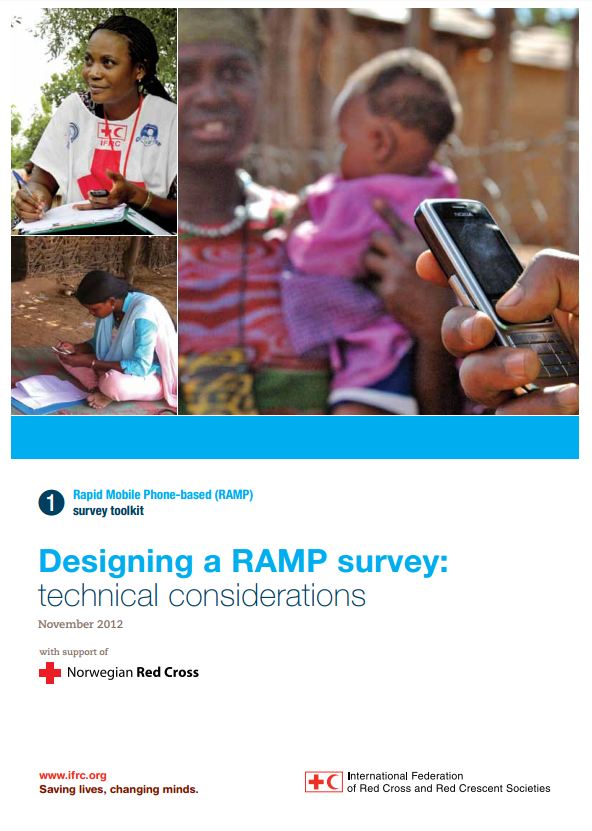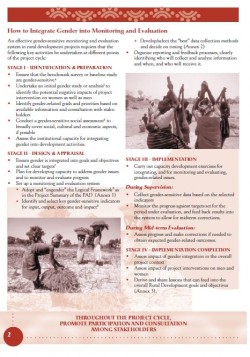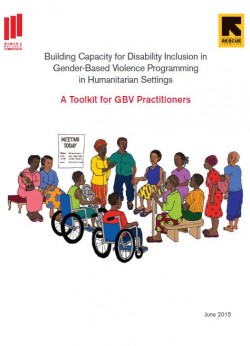Gender and Monitoring Evaluation Tool Kit: Excerpt
Purpose
This document looks at how to integrate gender into monitoring and evaluation at different points of the project cycle.
Overview
An effective gender-sensitive monitoring and evaluation system in rural development projects requires that the following activities be undertaken at different points of the project cycle:
- Stage I – identification and preparation: ensure that the benchmark survey or baseline study are gender-sensitive; undertake an initial gender study or analysis to identify the potential negative impacts of project intervention on women as well as men.
- Stage II – design and appraisal: ensure gender is integrated into goals and objectives and set clear targets; plan for developing capacity to address gender issues and to monitor and evaluate progress; set up a monitoring and evaluation system.
- Stage III – implementation: carry out capacity development exercises for integrating, and for monitoring and evaluating, gender-related issues.
Usage: Guidance for project implementation
Audiences: Technical staff; Gender and diversity practitioners
Reference: World Bank (June 2005). Gender and Monitoring Evaluation Tool Kit: Excerpt. Pp. 2-11. Available from: http://siteresources.worldbank.org/INTGENDER/Resources/RuralM_EToolkit2005.pdf [Accessed: 18th July 2016]
![]()
Building Capacity for Disability Inclusion in Gender-Based Violence Programming in Humanitarian Settings – A Toolkit for GBV Practitioners
Purpose
The toolkit contains 12 tools designed to support gender-based violence (GBV) staff to build disability inclusion into their work, and to strengthen the capacity of GBV practitioners to use a survivor-centred approach when providing services to survivors with disabilities. The tools cover three sections: disability inclusion in GBV programme planning; disability inclusion in GBV programme implementation; and monitoring and evaluating disability inclusion in GBV programmes.
Overview
The tools for each section are:
- Disability inclusion in GBV programme-planning: guidance on including people with disabilities and caregivers in GBV assessments; group discussion guide; and individual interview tool.
- Disability inclusion in GBV programme implementation: gender-based violence and disability: a training module for GBV practitioners in humanitarian settings; pre- and post-training test for the GBV and disability training module; guidance on communicating with people with disabilities; accessible information, education and communication (IEC) materials; guidance for GBV caseworkers: applying the guiding principles when working with survivors of disabilities; guidance for GBV service providers: informed consent process with adult survivors with disabilities; and working with caregivers of survivors with disabilities.
- Monitoring and evaluating disability inclusion in GBV programmes: reflection tool for GBV practitioners; and documenting “stories of change”.
Usage: Guidance for project implementation
Audiences: Technical staff; Gender and diversity practitioners
Reference: Women’s Refugee Commission (2015). Building Capacity for Disability Inclusion in Gender-Based Violence Programming in Humanitarian Settings – A Toolkit for GBV Practitioners. International Rescue Committee. Pp. 1-3. Available from: https://www.womensrefugeecommission.org/?option=com_zdocs&view=document&id=1173 [Accessed: 18th July 2016].
![]()




